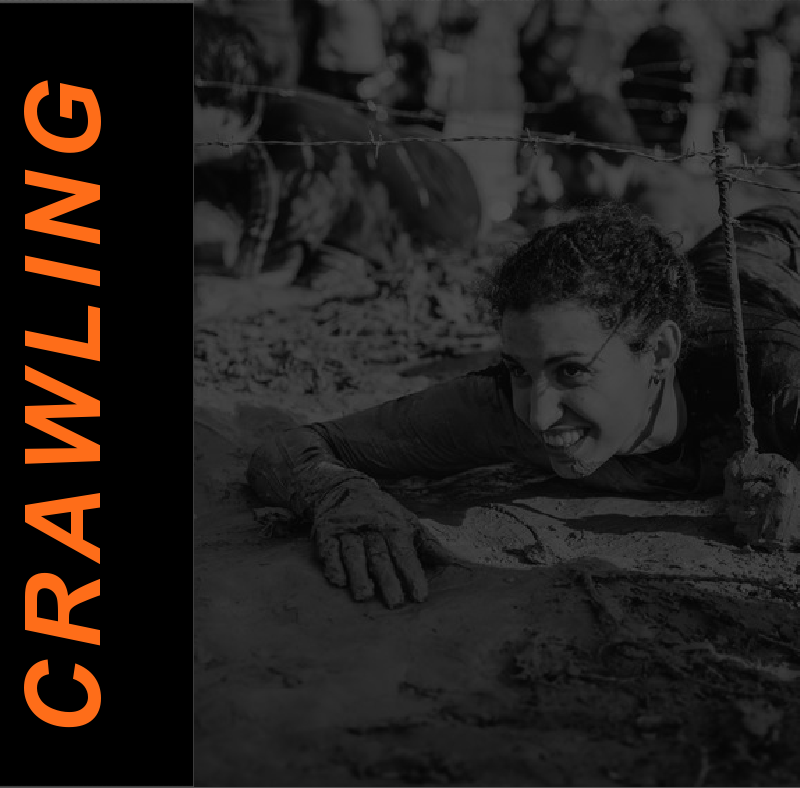
What comes to mind when you think of crawling? Crawling for strength and flexibility might not be your first thought.
Babies crawl before they walk. They crawl on hands and knees or on hands with straight legs. Many animals and crustaceans crawl, like alligators, bears, crabs and lobsters. On a hunt, animals often hunker down to be out of sight from their prey as the move in for an attack.
Soldiers crawl in combat to prevent being seen by the enemy. They learn to get so low that they can slide under barbed wire or crawl close to the ground to reduce the risk of being sighted.
While we aren’t hiding or hunting, exercise enthusiasts and fit pros often use crawling as part of a workout routine. Crawling has incredible physical benefits as well as mental advantages.
Those of us who have participated in mud races/obstacle courses have most likely encountered the need to crawl. It can be rough on forearms and knees, but you do what you have to do to finish. Crawling over tree roots, dirt and stones and maneuvering through tunnels and challenging obstacles, you quickly learn the value in training to crawl as an adult and competitive race participant.
Benefits of Crawling
Mind-Body Synergy
The brain and body work together for the ultimate benefit. “Crawling requires both sides of the brain to work together, because limbs on both sides of the body have to move synchronously (called a contralateral movement pattern),” wrote Brett Klika in an article Why Crawling Fixes Everything (January 11, 2018 on Acefitness.org).
“To make this happen, information must be passed through a ‘highway’ that links the two sides or hemispheres of the brain called the corpus callosum.” When an adult engages in crawling, it does take concentration. Going forward, backward, and laterally makes you pay attention to focus on the movement.
Build physical strength
Aside from engaging the brain, crawling wakes up muscles in the core, shoulders, and quads among other muscles depending on the type of crawl. Some crawls require more strength and others require more flexibility. I use crawling in training sessions and have yet to see a client excited about them. Once they conquer it, however, their attitude shifts.
Crawling is convenient
You can crawl just about anywhere. No gym equipment required. You can do it inside or out.
Types of Crawls
There are lots of types of crawls. Consider incorporating one or all of these in training sessions.
• Bear crawls start in a bear hold position with hips raised and straight arms. Move in one direction or in all directions. The core fires up.
• Lizard crawls begin in straight arm plank as one foot steps forward to meet the hand on the same side, then moving hands forward to go back to plank. Alternate sides. This helps with strength and flexibility. The hip flexors fire up.
• Army crawls have you low to the ground reaching arms forward as legs follow. This one wakes up everything.
• Baby crawls are basic and a good start for beginners. Simply crawl on hands and knees. Adding a yoga block on the back incorporates balance in this move.
• Walk-outs/inchworms begin standing, folding forward as hands crawl outward with straight arms. Return to standing or go into full plank/push-up.
• Crab crawls have the torso facing up with hands and feet on the floor to move back and forth. It certainly looks easier when crabs do it.
Crawling is one more way to add variety to workouts. The coordinating efforts of brain and brawn make it especially appealing.
Learn more in our Functional Training Specialist as a part of our Continuing Education Course Series.

References
https://www.acefitness.org/education-and-resources/professional/expert-articles/6907/why-crawling-fixes-everything/
https://www.muscleandfitness.com/workouts/workout-tips/3-ways-master-army-crawl/
https://www.thehealthsciencejournal.com/21-fun-crawling-exercises-crawl/






